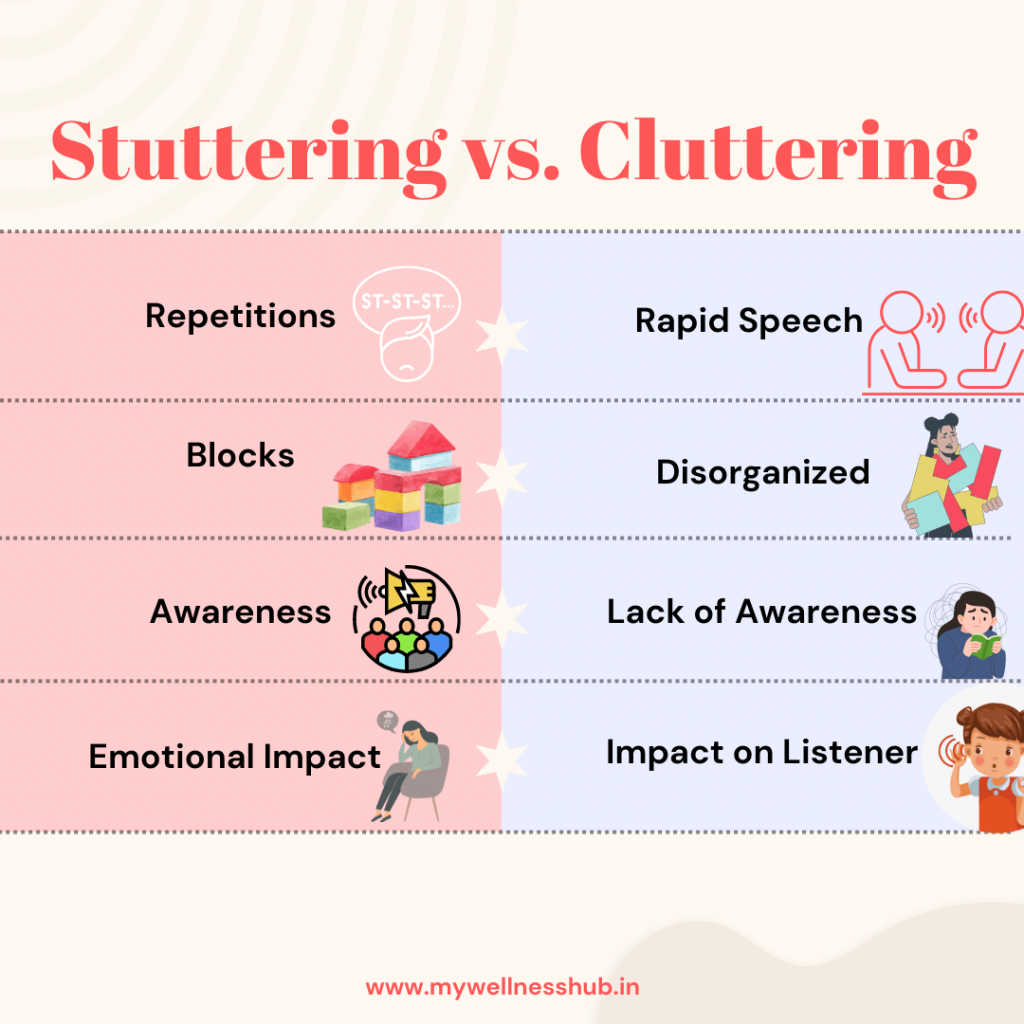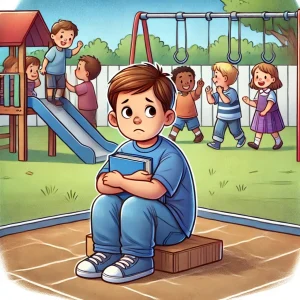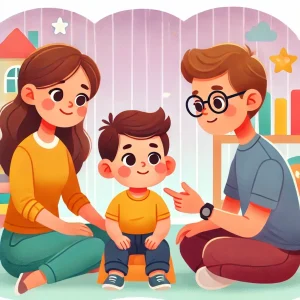Understanding Cluttering: How It Differs From Stuttering
By Rajini D
Last Updated: May 7, 2024
When we think about speech disorders, stuttering often comes to mind first. It’s a condition prominently portrayed in media and commonly discussed in educational materials, making it almost synonymous with speech-related difficulties. However, this narrow focus overshadows other important speech disorders that impact many individuals daily. One such condition is cluttering—a speech disorder that remains largely misunderstood and often mislabeled as stuttering.
What is Cluttering?
Cluttering is a lesser-known yet significant fluency disorder that can make smooth communication challenging for many individuals. Unlike stuttering, which might be more familiar to us, cluttering affects the flow and pacing of speech in unique ways that are not always immediately recognizable.
Common Symptoms of Cluttering
- Rapid, Disorganized Speech Patterns: Individuals with cluttering often speak at a pace that is difficult to follow. Their speech might burst out rapidly or at a variable speed, making it hard for listeners to keep up.
- Frequent Hesitations and Revisions in Speech: You might notice frequent pauses, hesitations, or corrections mid-sentence as they struggle to organize their thoughts or find the right words.
- Lack of Awareness of Speech Disfluencies: Often, those who clutter are not aware of their disfluent speech; they do not realize how their speech may come across to others, which differentiates it significantly from stuttering, where individuals are typically very aware of their speech patterns.
Know more: Understanding and Managing Speech Cluttering in Individuals
Impact on Daily Communication
These symptoms can significantly impact daily communication, affecting social interactions, academic performance, and professional achievements. It can be particularly challenging in fast-paced or high-pressure environments where clear and effective communication is crucial.
What is Stuttering?
Stuttering is a common speech disorder that touches many lives around the world, but despite its prevalence, it is often misunderstood. Known for affecting the flow of speech, stuttering is characterized by specific disruptions in the production of speech sounds, which are not just disruptive but also carry significant emotional weight for those affected.
Primary Characteristics of Stuttering
- Repetitions: This is perhaps the most recognizable symptom of stuttering. Individuals may repeat sounds, syllables, or words, such as “W-W-What” or “Let-let-let me go.”
- Prolongations: Longer holding of a sound within a word occurs in stuttering. For example, someone might say “Ssssssometimes” where the initial sound is drawn out.
- Blocks: Sometimes, there might be a pause known as a block, where no sound is produced despite efforts. This can be particularly frustrating as it feels like the word is stuck.
Emotional Impact of Stuttering
The emotional responses associated with stuttering significantly shape the experience of the disorder. Many individuals feel embarrassment or anxiety about speaking, particularly in public settings or stressful situations. These emotions can, in turn, exacerbate the physical symptoms of stuttering, creating a cycle that can be challenging to break.
Key Differences Between Cluttering and Stuttering
Understanding the distinct characteristics of cluttering and stuttering is essential for recognizing how each affects communication in daily life. While both are speech disorders, their impact on speech patterns and individual awareness differ significantly, which can influence their management and treatment approaches.
Comparison of Symptoms and Manifestations

Cluttering typically presents with rapid and disorganized speech patterns that can make understanding difficult for listeners. Clutterers often display bursts of speech interspersed with pauses and hesitations, and they may not follow the natural rhythm of conversational speech. This can lead to frequent misunderstandings or the need to repeat themselves, which can be frustrating in social and professional settings.
On the other hand, stuttering is characterized by repetitions, prolongations, and blocks that disrupt the normal flow of speech. These disruptions are often more noticeable than those seen in cluttering and can cause significant anxiety during conversations. Stutterers might avoid certain words or social situations they fear will trigger their stuttering.
Also read: Stuttering vs Cluttering: Understanding Speech Disfluencies.
Awareness and Self-Perception
A key difference between these disorders lies in the individual’s awareness and self-perception of their speech difficulties:
- Individuals with cluttering often have limited awareness of their disfluencies. They may not realize that their speech is unclear or disorganized unless pointed out by others, which can delay seeking help and treatment.
- Those who stutter are usually very aware of their speech difficulties. This heightened awareness can lead to increased self-consciousness and anxiety, which may exacerbate the stuttering, particularly in stressful situations.
Speech Flow and Interruptions
The nature of speech flow and interruptions also varies between the two disorders:
- Cluttering is often marked by an erratic flow of speech, including uneven pauses and abrupt changes in speech rate. These patterns can make the speech seem jumbled and difficult to follow.
- In stuttering, interruptions are typically more predictable, with certain sounds or words more likely to cause blocks and repetitions. This predictability can sometimes help stutterers with techniques to manage their speech, but it also makes the interruptions more evident to listeners.
Diagnosis and Assessment: Unraveling Speech Disorders
Accurately diagnosing speech disorders like cluttering and stuttering is crucial, not only for understanding the challenges an individual faces but also for crafting an effective treatment plan. The process involves more than identifying the disorder; it provides a deeper insight into the impact of these conditions on a person’s life and the best strategies for management.
The Importance of an Accurate Diagnosis
An accurate diagnosis is the first step towards effective treatment. It helps to distinguish between cluttering and stuttering, which, despite their similarities, require different therapeutic approaches. Misdiagnosis can lead to ineffective treatment and unnecessary frustration. Therefore, understanding the specific characteristics and manifestations of each disorder is essential.
Role of Speech-Language Pathologists
Speech-language pathologists (SLPs) play a pivotal role in the diagnosis and assessment of speech disorders. They use a variety of tools and techniques to evaluate the speech patterns, fluency, and communication skills of individuals. This assessment might include:
- Observation and Recording: Analyzing speech in different contexts and situations to note inconsistencies and specific difficulties.
- Standardized Testing: Employing tools designed to measure various aspects of speech and language.
- Client and Family Interviews: Gathering detailed backgrounds to understand the onset and progression of the disorder.
Diagnosis Criteria for Cluttering vs. Stuttering
| Criteria | Cluttering | Stuttering |
|---|---|---|
| Speech Rate | Rapid, erratic, uneven | Normal to slow with blocks |
| Awareness | Often unaware of disfluencies | Highly aware of speech difficulties |
| Speech Patterns | Disorganized, frequent revisions, erratic pauses | Repetitive sounds, prolonged syllables, blocks |
| Emotional Impact | Generally low emotional response to speech issues | Often, high emotional responses to anxiety and frustration |
Treatment and Management Strategies for Cluttering and Stuttering
Effective management of speech disorders like cluttering and stuttering involves tailored strategies that address the specific needs of each individual. At Wellness Hub, our approach combines cutting-edge techniques with personalized care plans to ensure our clients achieve the best outcomes.
Overview of Treatment Approaches
The treatment for cluttering and stuttering, while sharing some common techniques, is often specialized to address the unique aspects of each disorder. The goal is to improve functional communication and reduce the impact of the disorder on daily life.
- For Cluttering: The focus is on increasing awareness of one’s speech and improving speech rate control. Techniques may involve exercises to regulate speech rhythm and strengthen language organization skills.
- For Stuttering: Treatment often includes techniques to manage physical symptoms and reduce anxiety associated with speaking. This might involve controlled breathing, gradual exposure to speaking situations, and cognitive-behavioral strategies to build confidence.
Read more: 7 Key Techniques for Overcoming Stuttering
Specific Techniques Used in Speech Therapy
- Slowing Down Speech Rate: This is crucial for both disorders but is applied differently. For clutterers, it helps organize thoughts and ensure clearer articulation. Stutterers benefit from this as it reduces the rush to speak, which can decrease the frequency of stuttering events.
- Enhancing Speech Clarity: By focusing on articulation exercises, individuals can improve how they form sounds and words, leading to clearer and more effective communication. Techniques such as phonetic placement and auditory feedback are often employed.
Tailoring Treatment Plans to Individual Needs
At Wellness Hub, we understand that each person’s experience with a speech disorder is unique. That’s why our speech-language pathologists (SLPs) develop customized treatment plans based on a comprehensive assessment of each client. These plans consider several factors:
- Severity of the Disorder: More severe cases may require more intensive therapy and possibly integration of multiple techniques.
- Individual Goals: Whether a client wishes to improve professional communication or feel more comfortable in social settings, goals are integral to guiding therapy.
- Lifestyle Considerations: We consider each client’s daily activities and environments to ensure that the strategies are practical and sustainable.
Conclusion
Understanding cluttering and stuttering is crucial for anyone dealing with these speech disorders. Each has its own set of challenges, but knowing the differences helps in managing them effectively. Cluttering involves rapid, disorganized speech, whereas stuttering is marked by repetitions and hesitations. This knowledge is vital for both accurate diagnosis and effective treatment, helping individuals improve their communication and overall quality of life.
If you or someone you know struggles with these issues, professional help can make a significant difference. At Wellness Hub, our skilled speech-language pathologists provide personalized care tailored to each person’s needs. We’re here to support you through diagnosis and treatment, helping you achieve clearer communication and greater confidence. For more information or to schedule a consultation, visit our Speech Therapy Services at Wellness Hub. Together, we can overcome the challenges of speech disorders.
Frequently Asked Questions:
1. What is the main difference between cluttering and stuttering?
Cluttering is characterized by rapid and disorganized speech, which may be hard to follow. Stuttering typically involves noticeable speech interruptions like repetitions, prolongations, and blocks.
2. How can I tell if someone is cluttering instead of stuttering?
Someone who is cluttering may not be aware of their disorganized speech and will speak in bursts that are difficult to understand. In contrast, individuals who stutter are often very aware of their speech difficulties and may show physical struggle when speaking.
3. What are the best treatment options for cluttering and stuttering?
Treatment varies depending on the disorder but generally involves speech therapy to manage symptoms. Techniques may include slowing down speech, enhancing clarity, and psychological counseling for stuttering to address associated emotional issues.
4. Can cluttering and stuttering be treated at the same time?
Yes, it’s possible to treat both conditions simultaneously, especially if a person exhibits symptoms of both cluttering and stuttering. A speech-language pathologist can design a therapy plan that addresses both sets of symptoms.
5. What role do speech-language pathologists play in treating these speech disorders?
Speech-language pathologists assess and diagnose speech disorders and provide tailored treatment plans that include therapeutic exercises and strategies to improve speech fluency and communication effectiveness.
6. Where can I find help for cluttering or stuttering?
Professional help is available at speech therapy centers like Wellness Hub, where experienced speech-language pathologists provide personalized care. Visit Wellness Hub’s Speech Therapy Services for more information or to schedule an appointment.
7. How long does it take to see improvement in speech after beginning therapy for cluttering or stuttering?
Improvement timelines can vary based on the individual’s condition severity, therapy frequency, and personal effort in practice. Some may notice improvements within a few months, while others may need longer-term therapy.
8. Can adults benefit from speech therapy for cluttering or stuttering, or is it more effective for children?
Adults and children can both benefit from speech therapy. While early intervention is often beneficial, speech therapy is effective at any age, provided it is tailored to the individual’s specific needs.
9. What daily exercises can help manage cluttering or stuttering?
Daily exercises for managing cluttering might include practices to slow speech rate and improve speech organization, such as timed speaking drills and reading aloud with intentional pauses. For stuttering, techniques like controlled breathing, speaking slowly, and practicing smooth speech transitions can be beneficial.
10. Are there any online resources or apps that can help with stuttering or cluttering?
Yes, there are several online resources and apps designed to assist individuals with stuttering or cluttering. These tools offer exercises, real-time feedback, and tracking progress to help manage symptoms. Apps like Speech Tutor and DAF Assistant are popular among those seeking to improve fluency and speech pacing.
About the Author:
Rajini Darugupally
M.Sc., Speech-Language Pathologist (9+ years of experience)
Rajini is a passionate and dedicated Speech-Language Pathologist with over 9+ years of experience, specializing in both developmental speech and language disorders in children and rehabilitation in adults. Driven by a desire to empower each individual to find their voice, Rajini brings a wealth of experience and a warm, genuine approach to therapy. Currently, at Wellness Hub, she thrives in a team environment that values innovation, compassion, and achieving results for their clients.
Book your Free Consultation Today
Parent/Caregiver Info:
Client’s Details:
* Error Message









